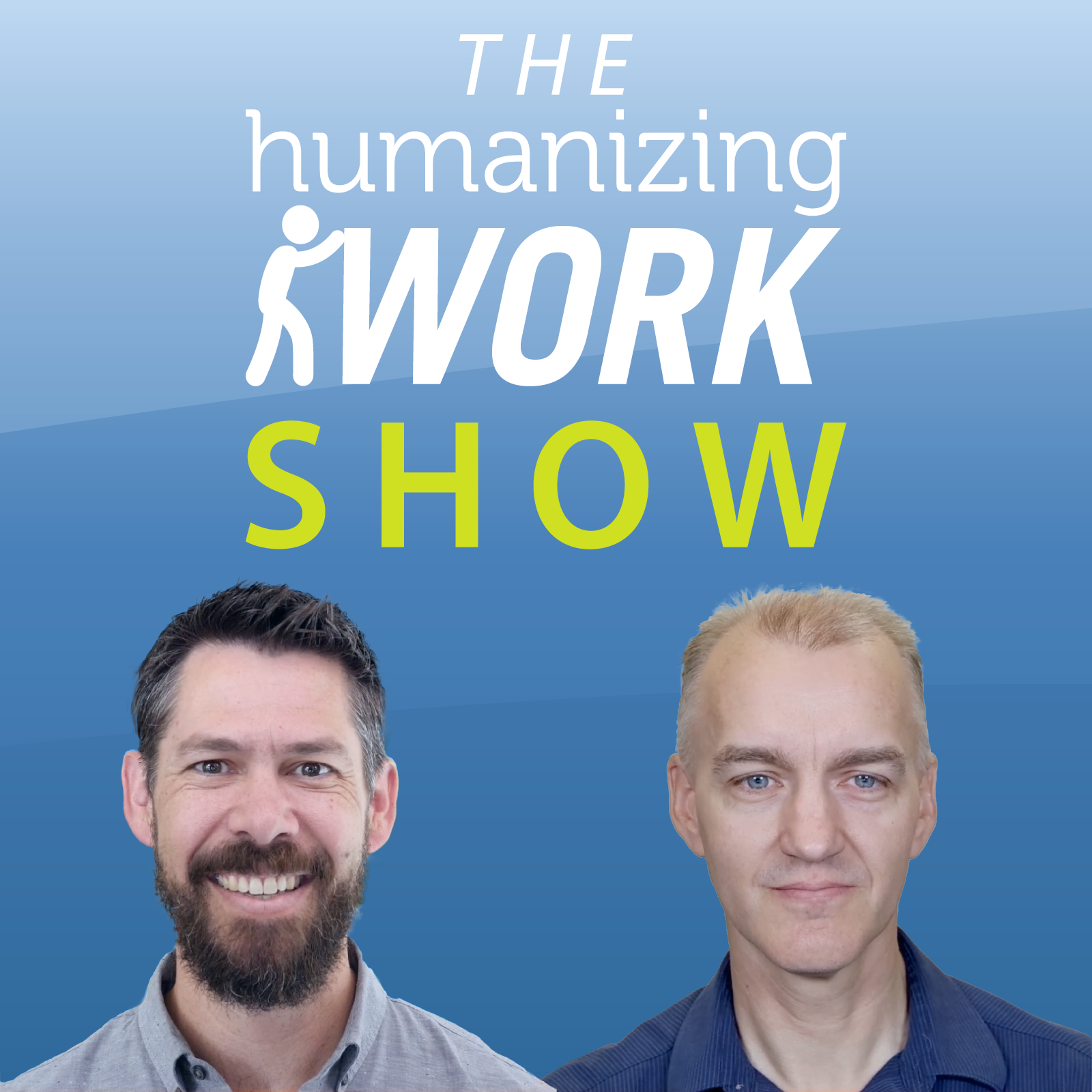Episode Transcript
Peter Green: Welcome to the Humanizing Work Show. I'm Peter Green here with Richard Lawrence. Several years ago I was asked to help change the DNA at Adobe to be more of a services company. This was gonna be done through a series of conversations and interviews. So I conducted those interviews. I put together a strong presentation from my perspective, and then I brought it in to share with the general manager of the business unit and several executive vice presidents.
Now, I framed the change that was needed as a change in leadership behavior and a change in culture at Adobe in line with what I thought was the goal of changing the DNA. About 10 minutes into that presentation, I realized this is not landing. None of the things I'm asking for are gonna happen despite all of the effort I put in, which was significant.
It was very painful, one of the most painful experiences I had in my time there. But as Ray Dalio says, pain plus reflection equals progress. And I had a lot of time to reflect on that and figure out how to do a better job of making presentations to leaders. Recently I was working with a vice president at a client's company, and this vice president wanted to get some budget and decision making approved in a pretty challenging economic situation where budget was tight and they weren't sure if they could get anything approved.
So I got to share what I've learned. And that vice president did an excellent job of making the business case, asking for a really specific thing, then making it easy for those executives to say yes. So today we'll share the advice we gave that Vice President, and really anyone who needs to report to management, present to a leader or to a leadership team, or make a persuasive argument at a meeting, can use this approach to increase your odds of a great outcome.
Richard Lawrence: This is good because the world is full of presentations that don't change anything in business and nonprofits. Your calendar is probably full of presentations that don't actually lead to change. So we all need to learn from Peter's mistakes, really all of our mistakes, and change that.
What we're gonna talk about today is that an effective presentation isn't a one-off event. It's not just about having the perfect slides and polished things to say. An effective presentation sits in the middle of a longer arc of persuasion. So to make it work, you need some pre-work before you have a meeting, a clear and convincing request in the room, and discipline follow up after.
Let's start with the pre-work.
There's a lot that you can do on your own and probably should do to start off, like writing your way into a point of view, gathering data, crunching numbers, making drawings that make processes clear, like make sure you're actually solving a real problem, that your solution will work, that you can overcome some key side effects, that you can show real business benefits from solving it.
Peter: And as I learned, all of that work only matters if it aligns with what the leader actually cares about, not just what you care about. Leaders sit in this world of constrained time, constrained money, constrained risks, optics, and politics. So your job is to make one good, low risk decision, very easy for them to make during the presentation.
And to do that, you need to get curious about what they care about. But you can't just guess. You need to talk to them. Whoever you can get time with, maybe this is chiefs of staff or trusted deputies. Even your own boss might have insight into this.
The conversations could be in the hallway. They could be informal or formal. What you're doing there is both a little bit of discovery, like what matters to them, and validation, saying all of these things i've put together, the data that Richard talked about, does that framing of the problem and the proposed solution land with them?
Richard: Mm-hmm. Now, just having a bunch of conversations doesn't get you a decision that's going to stick. I think how you have those conversations matters. And we've talked about the five levels of resistance from the theory of constraints before in previous episodes. We actually like to use that same kind of model here. But we think of it as five levels of alignment. So as we're having these conversations, we wanna continually test and refine alignment at five levels.
First, the problem we're solving, what do they see for the problem? What language do they use to talk about it? Why is it painful for them? A lot of times what we think the problem is isn't the way other people experience it. So we're testing and refining that first, and not just jumping straight to our proposed solution.
And then next, once we've got some alignment around the problem. We're testing whether our proposed solution will do something about it from their perspective. Next, side effects that could come up as we implement the solution, and how we're gonna mitigate those. I love involving other people in helping think through side effects and how they'll be mitigated before I ask for somebody to do something. It's a, a really good way to get ahead of potential resistance later.
Then fourth, what are some possible obstacles, especially financial, budget, time, prioritization, and do we have the resources to do this thing we wanna do? And how will we get them? And then last, who else needs to agree and collaborate if this is going to happen?
In that process, you may discover that your goals and theirs don't fully align. So sometimes there's some extra work to look for some overlap, or a compromise, or a breakthrough proposal that creates a win for both of you. And then as you refine your request, you may have to iterate back and vet it with some of those other pre-work allies that you've built.
Peter: So that pre-work phase is critical. But eventually, you're gonna need to get people in a room to decide, and that's an expensive use of time. The stakes are high, and so it's really important that you go into that meeting with real clarity and with an intent to tell a story about what matters most. So I would start by thinking carefully about who you invite.
So think about how the decision will be made, what level of delegation applies on the seven levels, as we've talked about on the show multiple times, and then craft a presentation around that clear vetted request that you did in the pre-work.
Richard: Yeah, I, I think that's so important, Peter, to have one clear request that you're leading towards.
I've sat in a lot of meetings where there's a presentation about a problem and a solution, and then you get to the end and people are wondering, so what are you asking? What do you actually want me to do? And one way I like to think about that thing is if I can only guarantee one thing happens at the end of this meeting that somebody does something, we may get more than one, but I could guarantee one thing happens, what does that one thing I want to guarantee? And then everything else points towards that.
But there's a mistake that people can make, especially more engineering types like me, which is assuming that people make decisions based on data alone. I'm gonna show you all the data that will lead to that one clear request. Of course, you need data. If you don't have that logical case, you lose credibility. But data by itself doesn't persuade. People make decisions based on emotions, values, and then they work their way back into logical justification for those things. And if you miss that, you can get people nodding and doing nothing.
So we often suggest that people build two versions of a presentation. One is the story-driven, focused presentation that looks more like a TED talk than like a report. And then the other would be a detailed appendix or report that you can draw on, that you can share as backup. You can say, I've got all the numbers here, but don't dive into a spreadsheet.
Get into why the thing matters, and tell stories about the problem and the solution and what it'll produce.
Peter: That point is really critical. Richard, and I've seen it as a thing that most of us aren't really trained in how to do well. We've been trained how to think logically and to think through process and outcome. And to tell a, a compelling story is a whole different skill set.
And so we like to use a pattern that is called "therefore, but." We actually learned this from the directors of South Park.
Richard: Those famous storytellers.
Peter: Famous storytellers, right. But you know, 27 seasons in and they've got something going for 'em, right? They use this pattern where they connect every scene with either the word "therefore," or "but." They're not allowed to say "and then." And what that does is it keeps these little arcs of tension going. This happened, but then, so it's a little cliffhanger between every scene.
This is how we script our episodes of the show now. This happened, but then, therefore, but, therefore...
we use this approach in presentations as well. So you start by restating whatever the problem was that you vetted with, uh, in your pre-work. Then you follow the pattern. And I'll give you an example of, uh, a real, slightly anonymized one that we did recently, where in this case, the leader said,
"our, our sales weren't performing after we shifted some strategies." So that was the first slide was, here's the problem. "Therefore, you all asked me to put this team together, and now we're hitting on all cylinders. But we're limited by a few constraints in doing even more. There's a bigger opportunity on the table. Therefore, we need more budget. We need a commitment to prioritizing our roadmap. We need to agree to spin up this other team. But that might bring up these side effects and obstacles. Therefore, I'd recommend we tackle the..., you can see the pattern. Therefore, but, therefore, but, and the pattern keeps tension.
It incorporates objections and concerns that you may have heard in that pre-work, and it walks people through the narrative arc that arrives at the final "therefore," which is "approve the proposal that I'm bringing." And if you've done the good job of storytelling, it almost feels inevitable. Like that's the obvious conclusion to draw based on the story I just told.
Richard: But you can leave that meeting excited that you got your proposal approved. You got your decision and then things drift or fall apart afterwards. So it's really important to end not just with the decision, but with, let's get a little project managery and figure out who does what, by then, how will we know we're making progress? How will we communicate about it? Let's write it down and send some notes out.
Because everybody is busy and other people, even if they just made a decision in favor of your proposal, they don't care about it as much as you do. Well, they might, but it's useful to assume nobody else cares about this as much as me, so I need to stay on top of it and make sure something happens.
Peter: And then after the meeting, there's follow up to do there. You need to keep that project manager hat on. In my experience, you need to follow up with people that said they would do a thing. You need to remind people that are gonna be involved. You may need to nudge things forward.
You can use some of the patterns that we've talked about on the show before for commitment and accountability to help people say, what are you committing to by when and how will I know? And then it's easy to hold them accountable for following up on those things.
Richard: So if you're trying to get like a budget to make a change happen, if you're trying to, uh, go to a workshop, maybe one of ours, uh, if you're trying to create an organizational change, you know, whatever it is. If you need to make a presentation to leadership to get a decision, there's three things to do.
First, the pre-work. Do your homework both on your own and in a one-on-one conversations with stakeholders to align your message with what other people care about.
Then as you craft a presentation leading up to a meeting, focus on stories and visuals that all move towards a single clear request. Have the, the data, the spreadsheets, the charts, the diagrams, but it often makes sense to keep those out of your actual presentation. Except occasionally, To have a slide for "shock and awe" purposes that is not intended to be read.
And then third, after you get the decision you want, actively follow up to ensure something actually happens. And remember that everyone's busy and they all have different priorities that may not align with yours.
Peter: If you have one of these meetings coming up and you feel like you're so busy that it's gonna be hard to do, or if you're trying to do it for the first time and incorporate some of these ideas, it's a lot to juggle.
Sometimes it's helpful to get an outside expert view. And it's exactly the kind of thing we love to help leaders and teams with at humanizing work. So grab a free coaching session on the contact page at humanizingwork.com and let's talk. We can help you build presentations that actually get results.
Richard: And as always, if you get value from this show, we would be grateful for your support. If you're watching on YouTube, subscribe like the episode, click the bell icon to get notified of new episodes. Drop a comment with your experience around this and what you've seen work or not work.
If you're listening on the podcast on Apple or Spotify or wherever else, we would be super grateful and encouraged by a five star review. And that would help other people who'd benefit from the show find it.
Peter: And thanks for tuning into this episode of The Humanizing Work Show. We'll see you next time.




